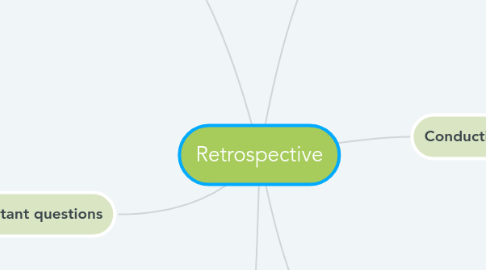
1. Types examples
1.1. 4Ls Retrospective
1.1.1. The 4Ls stands for Liked, Learned, Lacked and Longed For. It is a simple and popular technique for scrum masters and their team to highlight the positives (liked and learned), as well as the negative (lacked and longed for) from both a factual and emotional perspective.
1.2. Easy As Pie Retrospective
1.2.1. Easy As Pie is a good retrospective activity to look for improvements, to apologize for personal mistakes, to present new ideas and to recognise the good things.
1.3. Hot Air Baloon Retrospective
1.3.1. The Hot Air Balloon is a hybrid retrospective / futurespective that looks at what is helping / hindering the team and what positive / negative things are on the horizon
1.4. Marginal gains retrospective
1.4.1. The Marginal Gains instigate the participants to look for quick wins, the little things that could easily be done, adding up to great improvements. It is a retrospective activity for identifying and framing intentions, target outcomes and success criteria.
1.5. Starfish Retrospective
1.5.1. The Starfish retrospective is a technique to help teams reflect on varying degrees of actions and activities rather than simply the traditional what went well or what did not go well.
2. Important questions
2.1. What worked well for us?
2.2. What did not work well for us?
2.3. What actions can we take to improve our process going forward?
3. Responsibilities
3.1. Encourage full participation
3.1.1. Help foster a respectful and safe environment in order to invite everyone on the team to contribute their ideas.
3.2. Promote mutual understanding
3.2.1. Help the group understand each other so that they can achieve shared learning.
3.3. Foster inclusive solutions
3.3.1. Help the group find solutions that take into account divergent opinions and perspectives.
3.4. Cultivate shared responsibility
3.4.1. Help empower the group to take ownership of the outcomes of the meeting.
4. Conducting
4.1. Set the stage
4.1.1. Get the team ready to engage in the retrospective, perhaps with a warm-up activity such as Plus, Minus, Interesting
4.2. Gather data
4.2.1. Create a shared picture of what happened during the retrospective
4.3. Generate insights
4.3.1. Discuss what was successful and identify any roadblocks to success
4.4. Decide what to do
4.4.1. Identify highest priority items to work on and put measurable goals on those items so they can be completed
4.5. Close the retrospective
4.5.1. Reflect on the retrospective and how to improve it, and to appreciate accomplishments of the team and individual interactions
